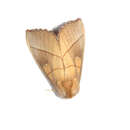Conservation Status
provided by University of Alberta Museums
A fairly common, widespread species.
- license
- cc-by-nc
- copyright
- University of Alberta Museums
Cyclicity
provided by University of Alberta Museums
Adults are on the wing from the end of May to late July. Larvae from late June through early Sept.
- license
- cc-by-nc
- copyright
- University of Alberta Museums
Distribution
provided by University of Alberta Museums
Transcontinental across the wooded portions of Canada, south to Florida and California. In Alberta, found mainly in the Boreal Forest region, north to the north shore of Lake Athabasca and the Peace River; less commonly in the Aspen Parklands.
- license
- cc-by-nc
- copyright
- University of Alberta Museums
General Description
provided by University of Alberta Museums
A fairly large (3.8-5.9 cm. wingspan) orange, yellow-brown or rusty-orange moth, with prominent antemedian and postmedian lines. There are a pair of diagnostic small silvery white spots in the center of the pointed forewing. Male antennae are bipectinate and the females have simple antennae. Unlikely to be mistaken for any other Alberta moth. The similar Notodontid moth Datana ministra should also occur in southern Alberta; it can be separated from Nadata by it's maroon head and thorax.
- license
- cc-by-nc
- copyright
- University of Alberta Museums
Habitat
provided by University of Alberta Museums
Deciduous and mixedwood forest and shrubland.
- license
- cc-by-nc
- copyright
- University of Alberta Museums
Life Cycle
provided by University of Alberta Museums
Adults are nocturnal and come to lights. There is a single brood, which overwinter as pupae. The larvae are solitary defoliators.
- license
- cc-by-nc
- copyright
- University of Alberta Museums
Trophic Strategy
provided by University of Alberta Museums
No Alberta data available. Elsewhere in Canada, a wide variety of deciduous trees and shrubs, with a very strong preference for white birch (Betula papyrifera), and to a lesser extent Red alder (Alnus rubra) and willow (Salix) (Prentice et al, 1962).
- license
- cc-by-nc
- copyright
- University of Alberta Museums
Rough prominent
provided by wikipedia EN
The rough prominent (Nadata gibbosa) is a moth of the family Notodontidae, subfamily Phalerinae. It is also known as the white-dotted prominent and the tawny prominent. The species was first described by James Edward Smith in 1797. This common moth is found across North America from the northern boreal forests to as far south as Florida. It is most common in deciduous forests at some elevation. It is nocturnal but attracted to lights. The moths start to fly soon after dusk and return to resting places some time before dawn breaks (Fullard & Napoleone 2001). The adults live through late spring and early summer, and larvae are active until fall. They then pupate until the following spring.
The moth is tan or dull orange, with two small silver spots on each forewing. The wingspan is approximately 2 inches (5 cm). It sports a pointed thoracic tuft between its wings.
Life cycle
Larva
The larva is blue green, turning bright green as it approaches pupation age. It has a large head capsule, yellow mandibles, and yellow longitudinal stripes down its body. It feeds on the leaves of oaks and other deciduous trees (see list below). The larva is sometimes called the green oak caterpillar.
Recorded food plants
References
-
Fullard, James H. & Napoleone, Nadia (2001): Diel flight periodicity and the evolution of auditory defences in the Macrolepidoptera. Animal Behaviour 62 (2): 349–368. doi:10.1006/anbe.2001.1753 PDF fulltext

- license
- cc-by-sa-3.0
- copyright
- Wikipedia authors and editors
Rough prominent: Brief Summary
provided by wikipedia EN
The rough prominent (Nadata gibbosa) is a moth of the family Notodontidae, subfamily Phalerinae. It is also known as the white-dotted prominent and the tawny prominent. The species was first described by James Edward Smith in 1797. This common moth is found across North America from the northern boreal forests to as far south as Florida. It is most common in deciduous forests at some elevation. It is nocturnal but attracted to lights. The moths start to fly soon after dusk and return to resting places some time before dawn breaks (Fullard & Napoleone 2001). The adults live through late spring and early summer, and larvae are active until fall. They then pupate until the following spring.
The moth is tan or dull orange, with two small silver spots on each forewing. The wingspan is approximately 2 inches (5 cm). It sports a pointed thoracic tuft between its wings.
- license
- cc-by-sa-3.0
- copyright
- Wikipedia authors and editors

